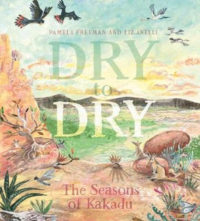
Title
Dry to Dry : The Seasons of Kakadu
Author
Pamela Freeman
Illustrators
Liz Anelli
Publisher, Date
Walker Books, 2020
Audience
5-8yrs, Lower Primary, Primary, Secondary, Upper Primary
ISBN
9781760650285
Language
English
Add to Favourites
-
Subjects
- Animal migration
- Birds
- Climate
- Ecology
- Environmental protection
- Kakadu National Park (N.T.)
- Monsoons
- Plants
- Seasons
- Weather
- Wildlife
-
Annotation
Kakadu is Australia’s largest national park and is dual World Heritage listed for both its natural and cultural value. The traditional owners are the Bininj and Mungguy people who lease the park to the Director of National Parks so that it can be jointly managed.
The picture book ‘Dry to Dry’ reveals the intricate ecology of Kakadu including its huge variety of plants and animals and their interdependence. It features a clever dual approach to imparting information. Each double page spread offers two texts. One is the narrative nonfiction text featuring visually rich, highly sensory and lyrical descriptions of the animals, plants and seasons in Kakadu. In a different font on the same page, there is a brief nonfiction text offering additional facts. The book’s final pages state that the Indigenous people of Kakadu know that there are six seasons, not just the wet and dry seasons portrayed in this book. The Indigenous names for these seasons are included. There are two maps of Australia, one featuring the States and Territories with Kakadu highlighted and another with landmarks, roads, plants and animals. The endpapers offer an aerial view of Kakadu.
The illustrations, covering the entire double page spreads, are crammed with intricate and mesmerising detail. They feature many half-hidden animals and plants, and through the course of the book these capture the changing landscape over the seasons. The index is like a puzzle encouraging the viewer to look again at each page and hunt for the large variety of plants and animals such as the sharp-tailed sandpipers, Leichhardt’s Grasshopper and other inhabitants of Kakadu.
Of special interest for this book is the YouTube resource where Liz Anelli explores her fascinating art techniques and how she constructed the images for this book.Series: Nature Storybook no 2
-
Teaching Resources
- https://www.youtube.com/watch?v=kszTLP0582g Dry to Dry. Liz Anelli talks about the making of the book including storyboarding, creation of a dummy book and art techniques, 24 August 2020
- https://www.facebook.com/ChildrensBooksDaily/videos/2768218400074067 Children’s Book Daily TBR Tuesday, Megan Daley discusses ‘Dry to Dry’ on Facebook, 11 August 2020
- https://parksaustralia.gov.au/kakadu/discover/nature/seasons/ Kakadu National Park. Six Seasons
- https://education.abc.net.au/home#!/media/1771788/indigenous-seasons-across-northern-australia ABC Education. Indigenous Seasons Across Northern Australia
- https://www.environment.gov.au/system/files/resources/5c6459fe-411a-47f3-a16e-09cddd9ec956/files/language.pdf Kakadu National Park, Aboriginal Languages
